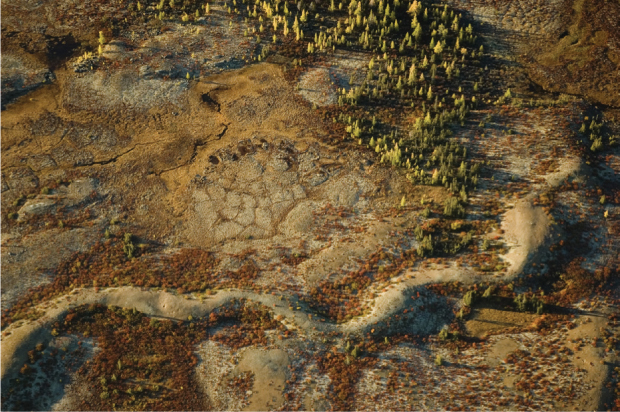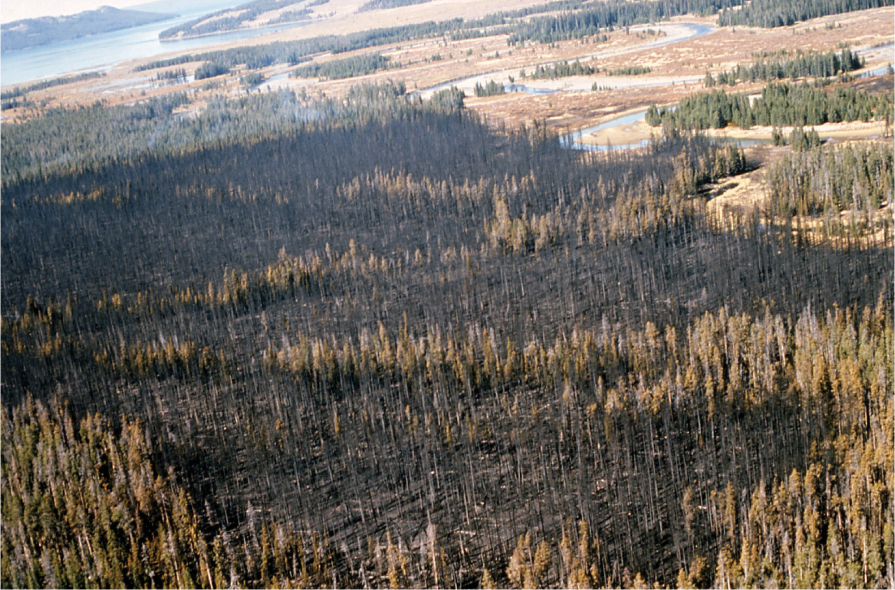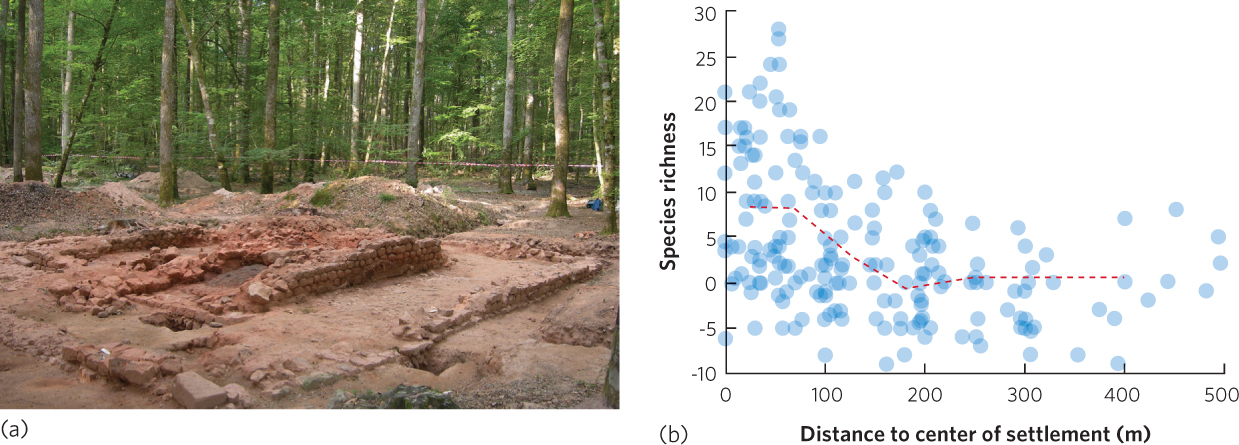Landscape ecology examines ecological patterns and processes at large spatial scales
Landscape ecology The field of study that considers the spatial arrangement of habitats at different scales and examines how they influence individuals, populations, communities, and ecosystems.
If you were to look across an expansive landscape from the window of a plane, whether in the mountains of the Cape Floristic Region or anywhere else, you would undoubtedly see a diversity of terrestrial and aquatic habitats comprising a wide range of sizes and shapes (see Figure 4.2). The field of landscape ecology considers the spatial arrangement of habitats at different scales and examines how they influence individuals, populations, communities, and ecosystems. In this section, we will discuss the sources of habitat heterogeneity and how this heterogeneity generates local and regional biodiversity.
Causes of Habitat Heterogeneity
The current heterogeneity of habitats reflects recent and historical events caused by both natural forces and human activities. Natural causes of habitat heterogeneity include geologic events such as the eruption of volcanoes and the advance and retreat of glaciers across continents. These events leave their mark on the landscape by moving large amounts of rock and soil and by creating water bodies and later changing their locations.
Long-lasting influences of historical processes on the current ecology of an area are known as legacy effects. An interesting legacy effect of glaciers that you can observe today is the presence of eskers, which are the remnants of long, winding streams of water that once flowed inside or under the glaciers. Over time, these glacial streams deposited soil and rock in their paths. After glaciers melt away, these old stream courses appear as long and winding hills (Figure 22.1). These hills harbor different microhabitats that favor unique plant and animal communities.

Legacy effect A long-lasting influence of historical processes on the current ecology of an area.
517
Natural forces continue to cause habitat heterogeneity in modern times. At both local and regional scales, catastrophes such as tornadoes, hurricanes, floods, mudslides, and fires can alter vegetation structure, which causes changes in populations and communities that depend on it. Although catastrophic events have always occurred naturally, human activity has influenced them. For example, the frequency and intensity of fires has changed over the years in the area in and around Yellowstone National Park. Natural fires were largely suppressed through much of the twentieth century. During the summer of 1988, however, hundreds of fires were ignited both by human activities and by natural causes such as lightning strikes. Most fires burned relatively small areas of less than 40 ha, but a few of the fires burned much larger areas. In total, nearly 500,000 ha burned, leaving a mosaic of burned and unburned patches across the greater Yellowstone landscape (Figure 22.2). The patterns of burning across the landscape depended on where the fires started as well as characteristics of the landscape such as the amount of combustible plant litter and local wind patterns.

As we saw in Chapter 18, some animals—for example beavers and alligators—are ecosystem engineers and can alter the habitats in a landscape. Humans are the most extensive ecosystem engineers; they build homes, offices, and factories, construct dams and irrigation channels, channelize waterways for improved navigation, and clear forests for lumber, paper, and agriculture. Logging provides a particularly clear example of a human activity that produces a mosaic of habitat types across the landscape. In the western United States, it is common practice to log medium-sized swaths of forest scattered throughout the landscape. This practice helps minimize soil erosion and other damaging effects of large-scale clear-cutting. It also produces a mosaic of forest patches of different ages. Logging is just one of many human activities that causes major effects on the landscape that can remain for many years.
Human activities can also cause habitat heterogeneity. For instance, during the first century ce, the Romans built small villages and farms in France. These farms were abandoned by the fourth century and the land reverted to forest (Figure 22.3a). Researchers studied the soil conditions and plant species located between 0 and 500 m from the former Roman settlements. They discovered that sites closer to the settlements had higher soil pH, more available phosphorus, and greater plant species richness, including many weedy species. The researchers attributed these legacy effects, which are shown in Figure 22.3b, to two causes. The slow breakdown of the ancient building materials contributed calcium and phosphorus to the soil. In addition, the Romans introduced numerous plant species to the area. In short, human habitation from 1,600 years ago continues to have strong legacy effects on the modern forest.

518
Relationships Between Habitat Heterogeneity and Species Diversity
When we quantify the number of species in a given area, we include a greater variety of habitats at the landscape level than at the local scale and therefore generally observe a larger number of species. For example, ecologists in Vermont recently surveyed bird species along 27 streams that feed into Lake Champlain. For each stream, they measured the physical characteristics of the stream itself, such as depth and width, and the types of habitats in the riparian areas along the stream banks. While each stream supported an average of only 17 bird species, the entire landscape of streams contained 101 bird species. The number increased significantly because different bird groups preferred different habitat characteristics. For example, waterbirds had their highest species richness and abundance in shallow streams whereas fish-eating birds were more abundant in larger streams with little agriculture along the stream bank because such streams provided more fish. In contrast, the richness and abundance of insect-eating birds was highest in areas containing a variety of habitat types, including shallow streams, meadows, and broadleaf forests. This mixture of meadow, forest, and stream habitats allows a greater variety of insect-eating shore birds and forest birds to exist and feed on the insects that emerge from the stream. Because the heterogeneity of habitat types across the landscape of streams supports a high richness of bird species, conserving a variety of habitats over a large area is critical to the conservation of bird species diversity.
Local and Regional Species Diversity
Local diversity The number of species in a relatively small area of homogeneous habitat, such as a stream. Also known as Alpha diversity.
The study of birds in the streams of Vermont highlights the fact that species diversity can be measured at different spatial scales. For example, if we consider the number of species in a relatively small area of homogeneous habitat, such as a stream, we are looking at local diversity or alpha diversity. If we consider the number of species in all of the habitats that comprise a large geographic area, we would be looking at regional diversity or gamma diversity. In the Vermont stream study, the regional diversity would be the entire list of 101 birds that the researchers identified across all 27 streams.
Regional diversity The number of species in all of the habitats that comprise a large geographic area. Also known as Gamma diversity.
519
Beta diversity The number of species that differ in occurrence between two habitats.
If each species occurred in all habitats within a region, then the species diversity at the local and regional scales would be identical. However, if species prefer particular habitats, then the number of species at a local scale would be less than the number of species at the regional scale. Moreover, the list of species in each local habitat would be different from each other. Ecologists refer to the number of species that differ in occurrence between two habitats as beta diversity. For example, imagine two streams in Vermont: Stream A contains five species not found in Stream B and Stream B contains three species not found in Stream A. Because the two streams differ by a total of eight species, the beta diversity is eight. The greater the difference in species between two habitats, the greater the beta diversity.
Regional species pool The collection of species that occurs within a region.
The collection of species that occurs within a region is the regional species pool, which serves as the source of species for all of the local sites within the region. The actual species that live in each local site depend on the species that exist in the regional pool and how well biotic and abiotic conditions at the local scale match the niche requirements of species in the regional pool. Therefore, species in the regional species pool are sorted among localities according to their adaptations and interactions, a process we call species sorting.
Species sorting The process of sorting species in the regional pool among localities according to their adaptations and interactions.
An example of species sorting can be seen in an experiment in which researchers set up artificial wetlands and manipulated a variety of conditions, including the fertility of the soil and the amount of flooding the soil experienced. The researchers then sowed the seeds of 20 wetland plant species into each wetland to see which plants would germinate and persist over the next 5 years. Of the original 20 species, one species failed to germinate in any of the wetlands and five others were unable to persist. Of the remaining 14 species, each wetland contained only three to five species by the end of the experiment. Moreover, there were particular combinations of plant species that survived under each wetland condition. These results confirmed that differences in local conditions cause the sorting of species from the regional species pool.